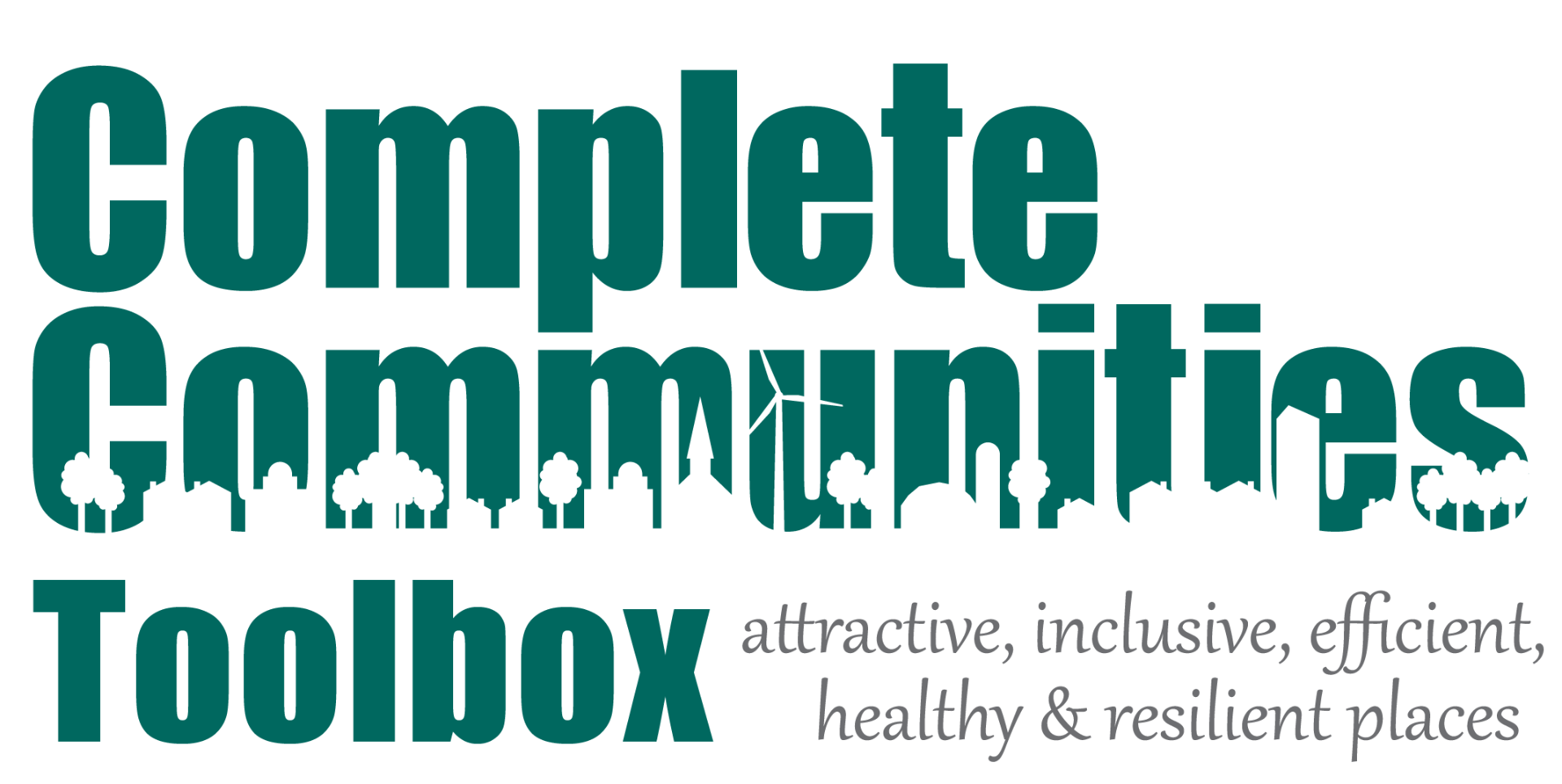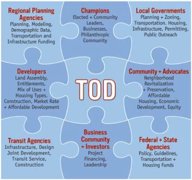What is Transit-Oriented Development?
Transit-oriented development (TOD) is defined as “walkable, compact, mixed-use, higher-density development within walking distance of a transit facility.” TOD generally provides a mix of residential and commercial uses and is designed to make public transit successful, enhance the convenience and safety of walking and bicycling, and provide for a vibrant, livable community. By 2025, 14.6 million households will demand homes within walking distance to public transit and rail systems. TOD can help meet some of that demand.
Source: http://transportpolicy2013.blogspot.com/2013/06/transit-oriented-development-without.htmlA community with transit-oriented development has five key characteristics:
- It contains a walkable, high-quality pedestrian environment that integrates streetscaping.
- The highest housing densities are located closest to the transit center in order to decrease sprawl and promote compactness.
- The transit center is also at the center of a destination that has a diverse, mixed-use development.
- Parking is carefully located, designed, and managed.
- Most importantly, the community has quality public transit facilities and service.
How is TOD compatible with Planning for Complete Communities?
 Transit-oriented development is compatible with planning for Complete Communities because it promotes dense, compact urban destinations. The concept also focuses on incorporating public transit and walkability into a community.
Transit-oriented development is compatible with planning for Complete Communities because it promotes dense, compact urban destinations. The concept also focuses on incorporating public transit and walkability into a community.
Benefits of Transit-Oriented Development
- TOD can improve public health. A community with a strong and dependable transit system and streetscaping elements can discourage vehicle dependence and congestion. A TOD community is thought to improve community health and even reduce obesity. A research article titled The Effect of Light Rail Transit on Body Mass Index and Physical Activity found that commuters who took a newly installed train were about 6.45 pounds lighter than those who continued driving to work.
- TOD can create a more sustainable community. The Center for Transit-Oriented Development reported in Planning for TOD at the Regional Scale that transportation contributes about 28 percent of all greenhouse gas (GHG) emissions. However, TOD has the potential to reduce annual GHG. The Delaware Valley Regional Planning Commission found in their GHG inventory that Philadelphia had lower transportation-related emissions per capita because of a higher reliance on public transit.
- TOD can strengthen local economies. Improving local public transit can cut vehicle transportation costs and time spent on commuting. With reduced commuting times and costs, people will be able to spend their time and money at restaurants, shops, and museums in the local area. The Center for Transit-Oriented Development reports that a compact community with a strong transit system can create jobs and also attract a young, innovative talent pool.
- A community with TOD elements costs less than suburban sprawl. Sprawl development is costly because it requires the expansion of public infrastructure and utilities. TOD promotes a compact community and uses existing infrastructure. A transit-dependent community saves money on repairing infrastructure as vehicle use decreases.
How is TOD being applied in Delaware?
Local governments in Delaware are beginning concerted efforts to advance TOD. More communities are recognizing the value of promoting economic growth through walkable, transit-oriented environments. Several existing transit stations/transit hubs, or transit-friendly locations are being eyed to plan for TOD.
Transit-Oriented Development (TOD): Identification of Optimal Site Characteristics in Delaware, a 2010 publication by IPA, establishes a preliminary framework to identify and evaluate ideal site characteristics for potential TOD sites in Delaware. The report provides a quantitative TOD-scoring framework for site evaluation that includes factors such as adequate zoning, congruence with local/regional land use plan, public support, public-private partnerships, and fully integrated transportation system. The scoring framework was applied to:
- Dover DART Bus Hub Station
- Newark Commuter-Rail Station
- Wilmington Commuter-Rail Station
- Claymont Commuter Rail-Station
- Churchman’s Crossing Commuter-Rail Station
- Potential Edgemoor Commuter-Rail Station
Since publication of the report, WILMAPCO submitted and received both a TIGER II and TIGER IV grant to develop and implement a Newark Regional Transportation Center Plan.
Funding will be used to create a regional transportation center at the site of the proposed University of Delaware’s (UD) Science and Technology STAR campus, a transit-oriented development (TOD) on the 272-acre former Chrysler Assembly Plant site. The multi-phased, multi-year project will provide improvements to the property that will accommodate expansion of the passenger rail transportation, integrate other transportation modalities, and address the conflict between freight and passenger rail at the site.
Conceived, sponsored, and implemented by the Dover/Kent County MPO and Downtown Dover Partnership in cooperation with the City of Dover, a Dover Transit Center Neighborhood Plan and Design Book was adopted in 2011. The plan and design guidelines provides the City of Dover with a design and planning strategy to guide the development around the new transit center site. The plan also offers strategies to improve all modes of transportation throughout downtown to make Dover a more transit-friendly community. The plan targets an area to spur downtown reinvestment, stimulate mixed-use development opportunities, and create a civic plaza on Water Street.
How Local Governments Can Begin Planning for Transit-Oriented Development
Community Visioning
The greatest challenges to TOD are community resistance and an unsupportive regulatory framework. While adjacent property owners may fear that TOD will take away from the character of a neighborhood or cause traffic congestion, TOD has been shown to be pedestrian and bicycle friendly, support local businesses, boost property values, and combat sprawl. Community members and stakeholders should be engaged in planning activities that form the basis of future land uses around existing and future transit locations, identify future transit station/hub location(s), and assess multimodal transportation needs related to such facilities.
Review Regulatory Framework
To support TOD, local governments should review their regulatory framework. Comprehensive plans and master plans should incorporate the need for TOD and path for policy implementation. In addition, zoning and land development ordinances need to encourage and support transit-supportive development patterns and redevelopment strategies.
Zoning ordinances and land development codes should not be solely designed for automobile-oriented, single-purpose, suburban-scale development. The physical requirements of zoning ordinances may need to be amended to support the development density necessary for TOD. Maximums on floor area ratio (building floor area divided by lot area), height limitations, minimum front setback of buildings, landscaping requirements, lot coverage maximums, and minimum parking requirements should be reviewed, and possibly amended, to provide transit-supportive uses and more intensive development patterns.
Design standards may be developed and adopted by a local government to provide visual guidelines regarding building and facility design, site planning, and transportation enhancements. Favorable design features/elements of TOD-related improvements and transportation facilities should seek to:
- Increase ridership
- Improve the customer experience
- Boost system efficiency
- Improve the public image of transit
- Enhance safety and accessibility
- Promote community livability
TOD Planning Process
The process for planning for TOD may vary by community. A TOD study may be initiated once a community has adopted a transit-supportive regulatory framework (including comprehensive plan and codes). The purpose of a TOD study is to determine the need for improvement of a community’s transit-served area(s) and assess the potential for TOD around a future transit station/hub. Components of a study process may include:
- Identification of issues, opportunities, and constraints;
- Preparation of a master vision plan;
- Development of circulation plans, transportation/transit access, and parking plans;
- Development of design standards and/or streetscape design features;
- Development of transit-supportive land use recommendations; and
- Recommendations for implementation priorities, potential funding partnerships, and project phasing.
To ensure input from all stakeholders, public engagement plan should be devised. A town’s planning commission, a special TOD study committee, or advisory can be formed to oversee the planning process and engage community members. To facilitate the planning process, a community may wish to enlist consultation services. Metropolitan planning organizations, such as the Wilmington Area Mapping Council (WILMAPCO) and Dover/Kent County Metropolitan Planning Organization, have assisted communities by conducting public visioning workshops, preparing public participation plans, crafting transit-center neighborhood plans and design guidelines, and preparing regional TOD plans.




